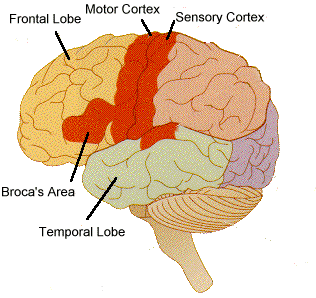
Neuroanatomy: The Systems

The Nervous System
The human body is composed of two nervous systems: the Central Nervous System (CNS) and the Peripheral Nervous System (PNS)
Central Nervous System
The CNS is comprised of the brain and the spinal cord

Brain
The brain is divided into three main parts: the prosencephalon (forebrain), the mesencephalon (midbrain), and the rhombencephalon (hindbrain).

-
Prosencephalon (Forebrain)
-
Telencephalon: this area contains the cerebral cortex, which contains the left and right hemispheres
-
Diencephalon: this area contains structures of the subcortex (structures you would see in the middle if you were to cut the brain in half, or mid sagittal cut). These include: the thalamus (relay station for the senses), lateral geniculate body (involved in visual function), hypothalamus (physiological body regulator), posterior pituitary gland (endocrine gland involved in growth and development)
-
The basal ganglia is another important subcortical structure that’s linked to the thalamus (lateral of it) that sits at the base of the brain and is, generally speaking, involved in the coordination of movement
-
-
An important landmark in the brain that is part of the prosencephalon is the longitudinal fissure. This fissure is the marker that separates the two hemispheres of the brain.

Another important structure in the prosencephalon is the corpus callosum. You can think of this structure as the information highway. Because the brain works in a contralateral fashion (left side controls the right side and vice versa), the corpus callosum acts as medium between the two hemispheres, communicating all kinds of information (sensory, motor, visual, auditory, etc.) to the other side of the brain in order to be fully processed.

**Darker tissue of brain and spinal cord is known as gray matter, consisting of nerve cell bodies and dendrites
-
Mesencephalon (Midbrain)
-
Reticular formation: this nerve pathway s involved in the process or alertness and consciousness
-
Substantia nigra: this is the nucleus of the basal ganglia. It is especially important in the production of the neurotransmitter dopamine (you might remember that dopamine is associated with the “pleasure” system. It is also plays a huge role in movement and cognition)
-
-
Rhombencephalon (Hindbrain)
-
This area is home to the pons and the medulla oblongata (the brainstem) as well as the cerebellum (balance & coordination). The brainstem is what connects the brain to the spinal cord.
-

There is a phrase ontogeny follows phylogeny, which simply states that just as humans develop from an embryo to an adult, animals go through the same stages, these developmental stages are the same across species. Think about evolution and how the brain develops over time

Also, composed in the brain is the ventricular system, which is a set of communicating cavities within the brain. Within this system, there are four ventricles:
-
Right and left lateral ventricles: each located within their respective hemispheres. These are the easiest to spot because they have “horns” which project into the lobes
-
Third ventricle: situated between the right and left thalamus (there are two of every structure in the brain)
-
Fourth ventricle: lies within the brainstem, between the pons and medulla oblongata. It receives cerebrospinal fluid (CSF) from the third ventricle via the cerebral aqueduct (a small canal containing fluid)

Spinal Cord
The spinal cord is protected by many layers of tissue, including: the skull, the meninges, cerebrospinal fluid, and the blood brain barrier
-
Meninges: three protective tissues that envelop the brain and the spinal cord
-
Dura mater: the toughest, outermost tissue enveloping the brain and the spinal cord. This particular layer is prone to tear in the elderly from minor falls, which can lead to subdural hematoma and dementia
-
Arachnoid mater: the middle, fine, and delicate connective tissue that anchors blood vessels to the brain. The space beneath this is called subarachnoid space, which is filled with cerebrospinal fluid.
-
Cerebrospinal fluid (CSF): clear, colorless liquid generated by the chorid plexus, that surrounds and protects the brain and spinal cord from shock and injury. It also circulates nutrients from the blood and eliminates waste products from the brain.
-
-
Pia mater: the thin, innermost membrane on the cortex, which provides protection from infection.
-

**Gray matter is reversed in spinal cord, with it being the innermost tissue
-
Blood brain barrier (BBB): a semi-permeable barrier that separates the brain from the circulatory system and protects the CNS by preventing potentially harmful chemical substances in our blood from getting into our brain tissue.


Other very important landmarks of the brain are the central sulcus and lateral (or Sylvain) fissure. The central sulcus separates the frontal lobe from the parietal lobe. The lateral fissure separates the temporal lobe from the frontal lobe. In addition, central sulcus separates the primary motor and sensory cortices.


Lastly, and most importantly, the spinal cord gives way to the 31 pairs of spinal nerves. They include:
-
8 pairs of cervical nerves
-
12 pairs of thoracic nerves
-
5 pairs of lumbar nerves
-
5 pairs of sacral nerves
-
1 pair of coccygeal nerves

Here's a quick video to sum up the Central Nervous System!
Peripheral Nervous System
The PNS contains essentially everything other than the brain and spinal cord. It can be divided into two smaller systems:
Somato-sensory nervous system:
controls voluntary movement, contains the 12 cranial nerves and 31 spinal nerves, and has a combination of sensory and motor neurons
--> The 12 cranial nerves are mixed (motor or sensory) and have an important role in speech and language functions

Autonomic nervous system:
controls involuntary movement, controls the internal body (i.e. heart, lungs, visceral organs, and glands). This system has two smaller subdivisions.
-
-
Sympathetic: which is involved in stress-related reactions “flight or fight” (So if a man held a knife out and asked for all your money, what would you do?)
-
Parasympathetic: involved in post-stress stabilizing reactions “rest and digest”
-

